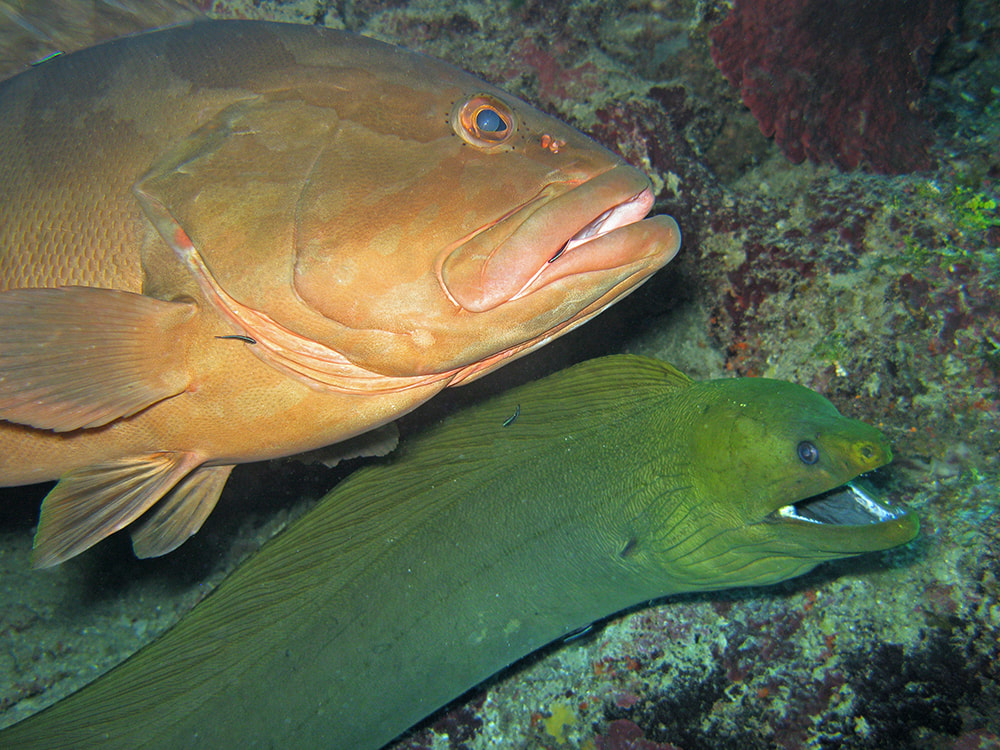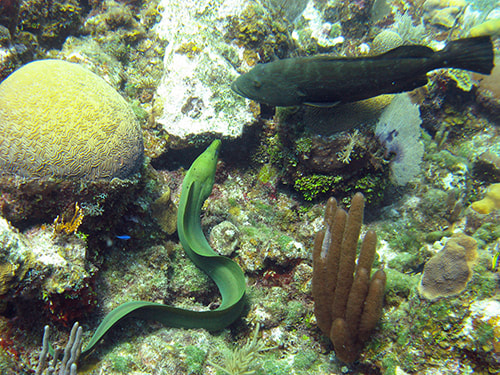How it works:
Each of these predators has a special set of hunting skills. Groupers are often ambush predators, using wide oversized jaws to suck their prey in whole, but they are also capable of fast short bursts of speed through the water. Morays have a very different hunting strategy: they are built to work thier way into crevices in the reef to get at thier prey, with no pectoral fins or gill plates to get stuck in the reef. Together these species can cover more hunting ground, with the grouper in the water column above and the moray working inside the reef below. There is little chance of escape when these two hunting strategies are combined. Once cornered, the prey can either stay in hiding until the moray comes in to get it, or risk the water column again, where the grouper's powerful jaws are already waiting.
Both the Black Grouper and the Green Moray can live for up to thirty years and they are both highly territorial. So it's safe to say that these two know each other, and have even grown up together in the same reef "neighbourhood", and rather than fighting over food sources, they've worked out how to make the most of having another big carnivore in the area. Here on Roatan, we've found the same two animals buddied up on the same stretch of reef, year after year, and already being in this cooperative "team-hunting" mode, they don't seem to mind being followed and observed.
Recent Discoveries:
A study by Redouan Bshary of the University of Neuchatel, Switzerland has uncovered how groupers can start one of these team-hunting sessions. While studying cleaning stations in the Red Sea, Bshary noticed groupers communicating with morays and investigated. (Geeks can read: Referential gestures in fish collaborative hunting, and watch the video and lab experiments below.)
Usually a solitary hunter, if a grouper misses it's prey and it tries to hide in the reef, the grouper rushes off to find a moray at it's favorite resting spot. As the grouper approaches, it shakes it's head back and forth rapidly (3-6 shakes a second) in a signal that means "I've got something!". The moray follows the grouper back to the area, where the the grouper does a "headstand", pointing it's snout down at the hole where the prey is hiding and shaking it's head again, in a gesture that means: "It's in here!". The moray goes in for the kill, or the prey makes a dash for it towards the waiting grouper. Either way, one of them gets a meal.
All that time Norman was trying to communicate with us: "Over here, dummy!" If only we spoke Fish.
Happy hunting! Mickey Charteris
3 Comments
|
AuthorMickey Charteris is an author/photographer living on Roatan. His book Caribbean Reef Life first came out in 2012 and is currrently into it's sixth printing as an expanded fourth edition. Archives
August 2019
Categories
All
|





 RSS Feed
RSS Feed